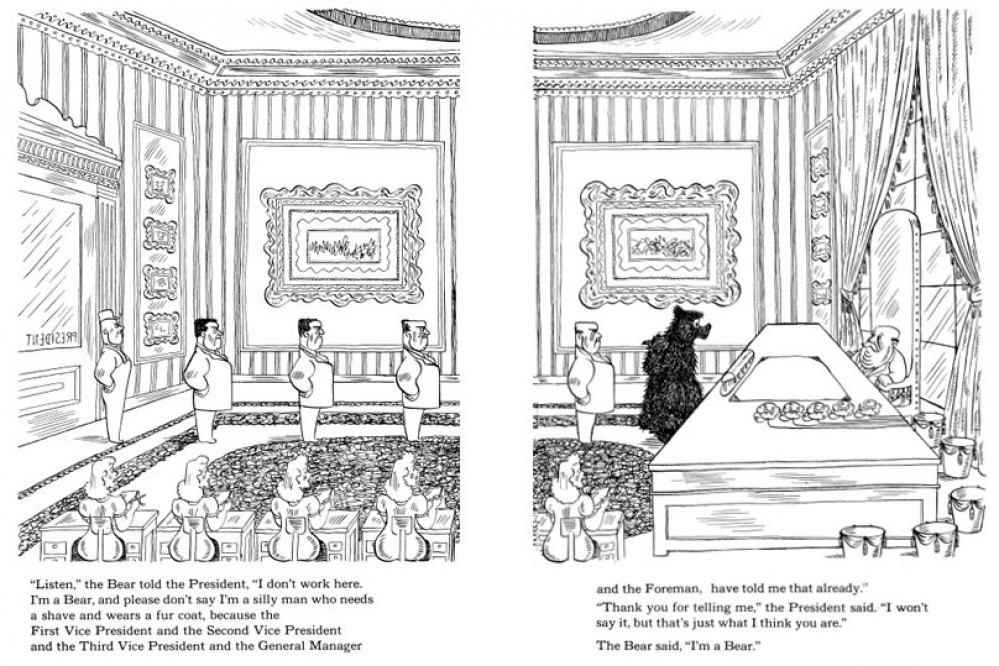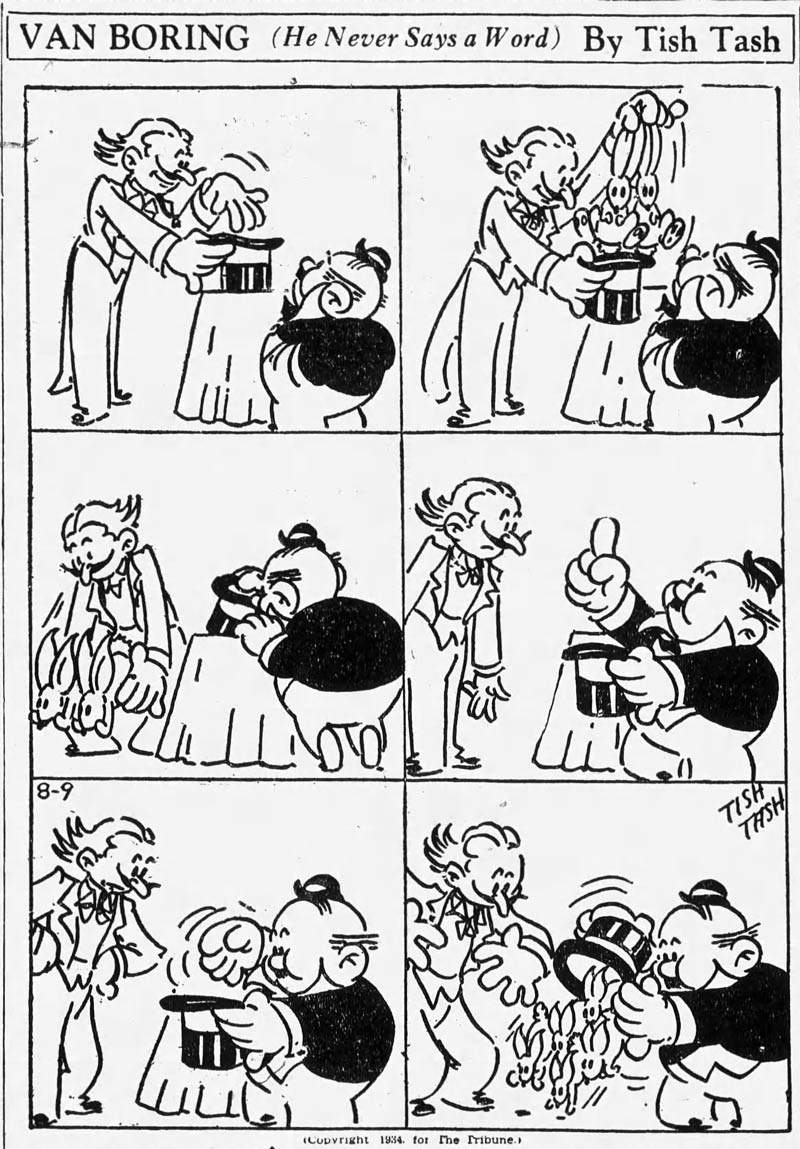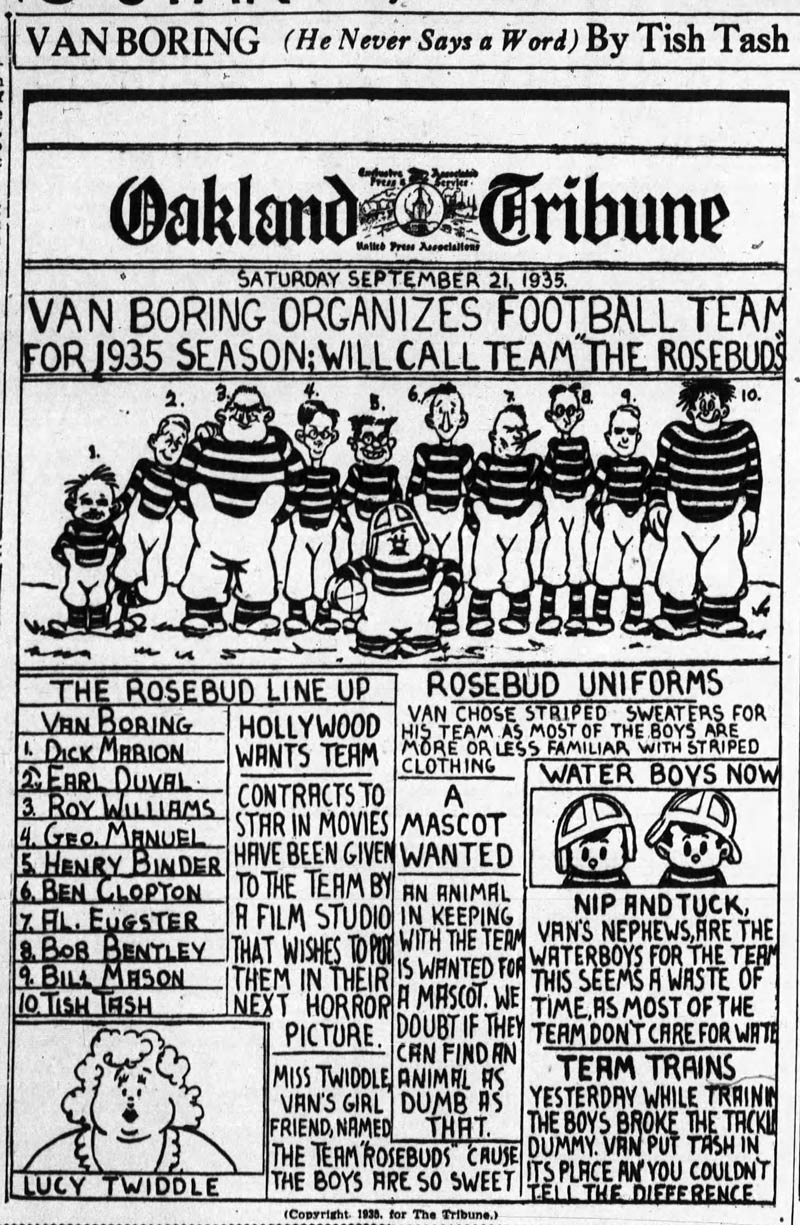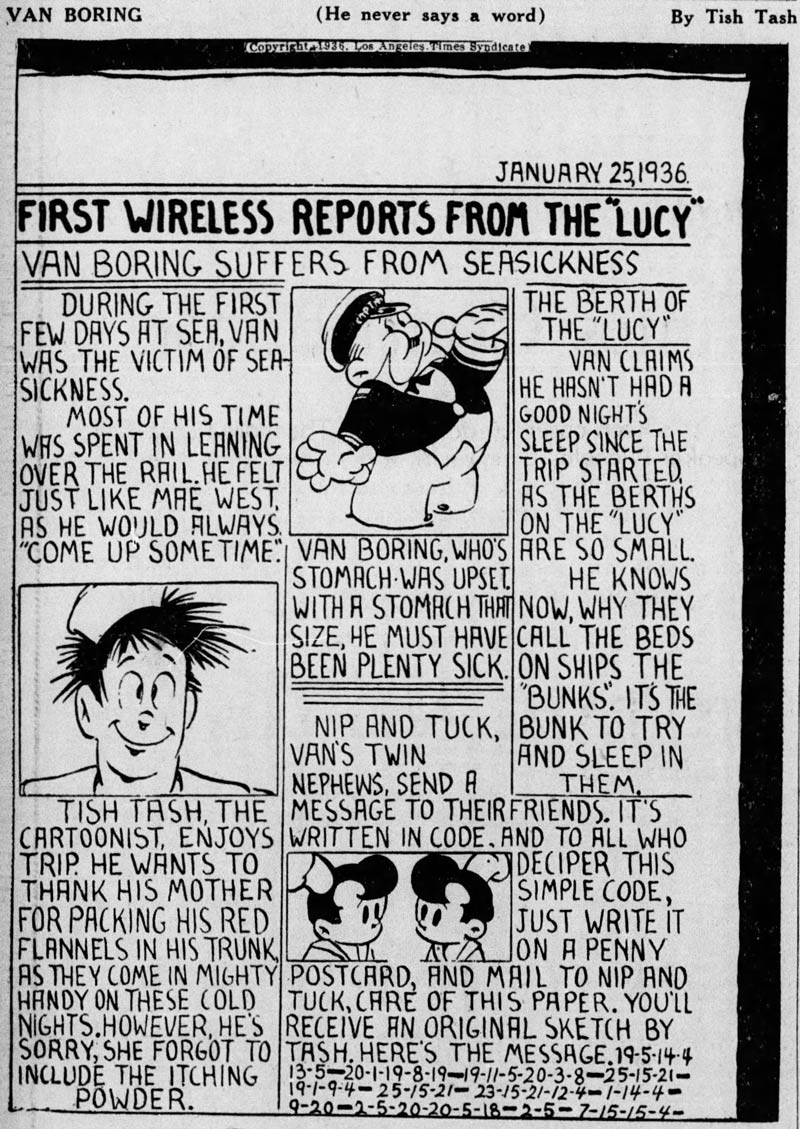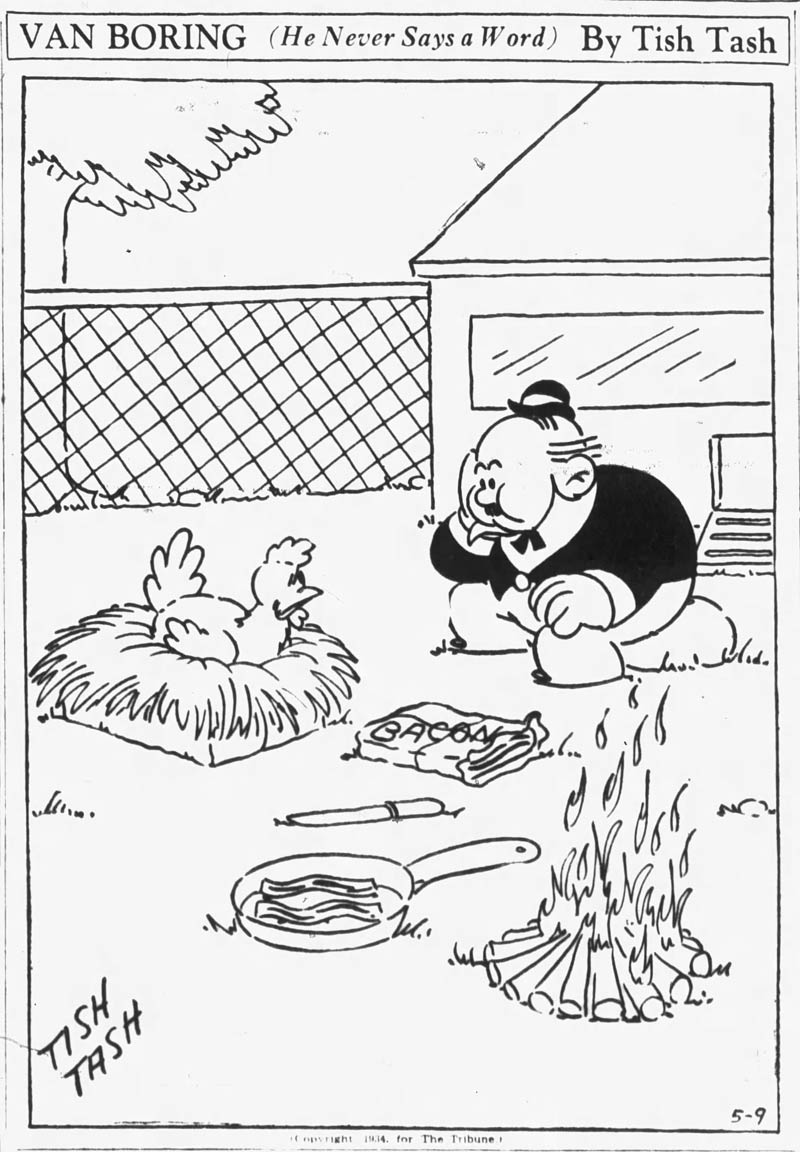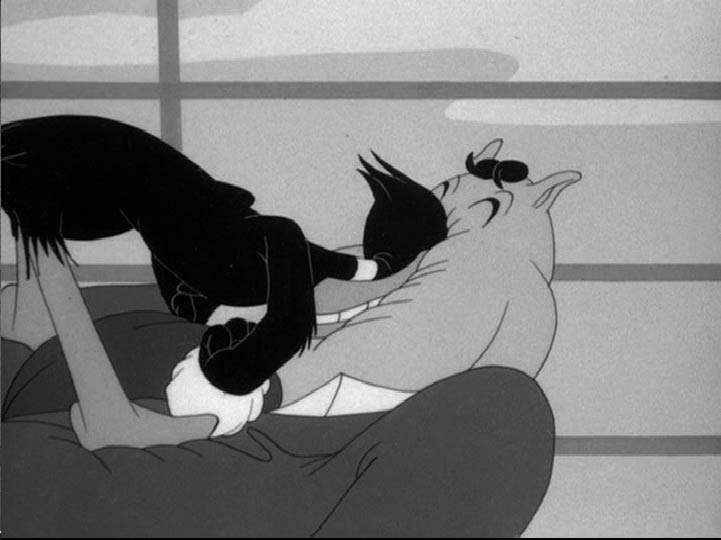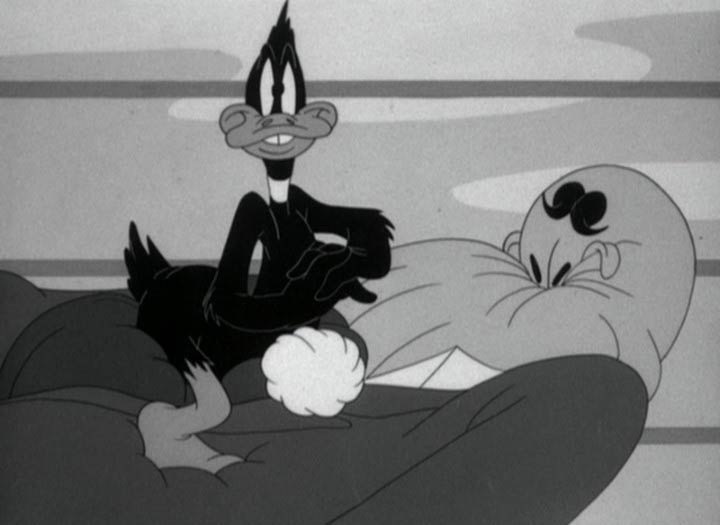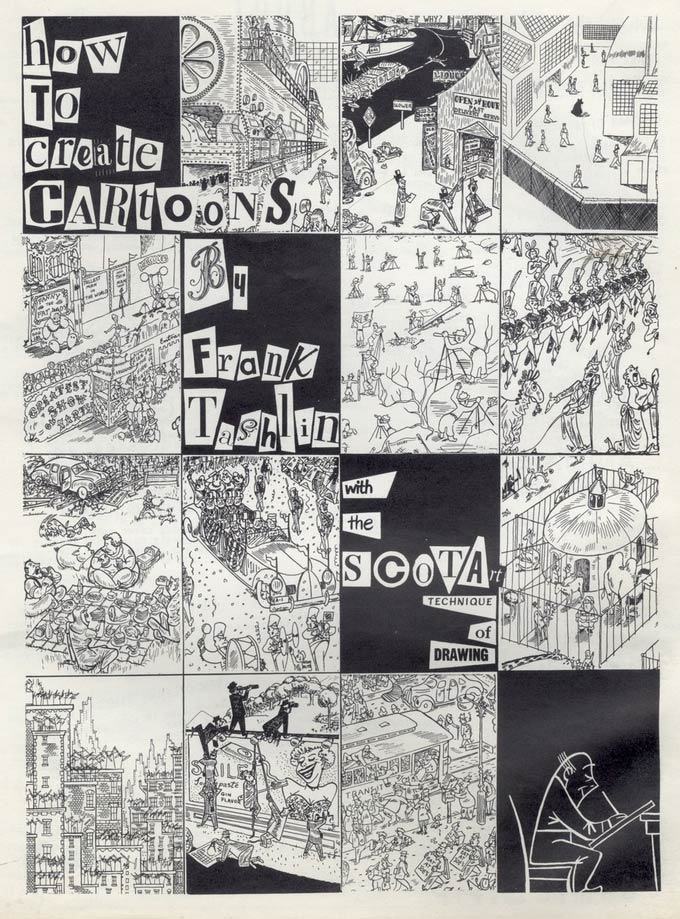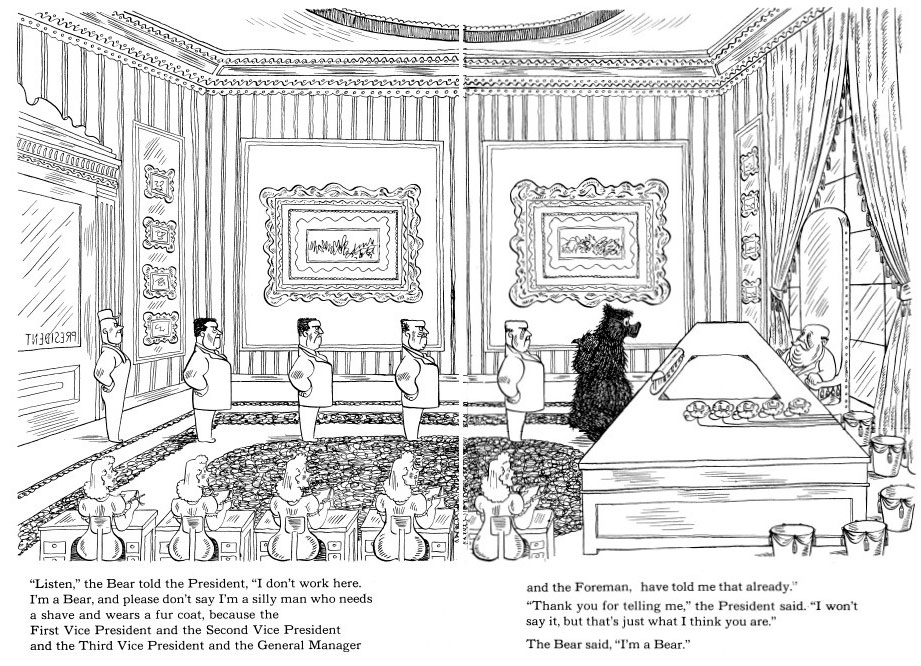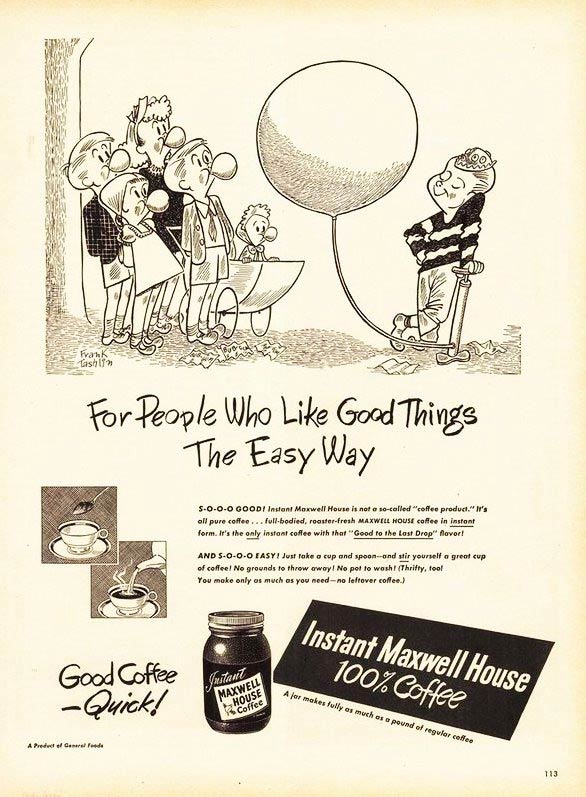'Van Boring' (Oakland Tribune, 9 August 1934).
Frank Tashlin was a versatile artist, whose resumé reads like a "who's who in mid-20th century comedy". He was active in several fields: animation, live-action films, children's literature and comics. Tashlin worked for nearly all the major animation studios during the Golden Age of the medium, including Warner Brothers. Even though his career there wasn't longer than a mere four years, scattered between 1933-1934, 1936-1938 and 1943-1944, his Looney Tunes cartoons remain his most enduring work. In the 1940s, he made several classic shorts starring Porky Pig and Daffy Duck. Like all his colleagues, he delighted in zany comedy and gags which broke the fourth wall. He also created Porky's girlfriend, Petunia Pig. However, his most important contribution to the studio was done in the field of editing. Inspired by live-action films, he introduced quicker camera cuts and more unusual camera viewpoints. Later in his career, Tashlin became a live-action director, specializing in comedies, the majority starring Bob Hope or Jerry Lewis. The line between cartoon and live-action often blurs in his work. His animated shorts have cinematic finesse, while his live-action comedies feature cartoony gags. His most timeless classics are the rock 'n' roll musical 'The Girl Can't Help It' (1956) and the satirical picture 'Will Success Spoil Hunter?' (1957). The inexhaustible artist also wrote four illustrated children's books, of which 'The Bear That Wasn't' (1946) is the best known. As a cartoonist, he made the gag-a-day comic 'Van Boring' (1934-1936). Frank Tashlin remains one of the few famous live-action film directors to have drawn comics in their career, along with Jan Bucquoy, Damiano Damiani, Don Dohler, Federico Fellini, Terry Gilliam, Alejandro Jodorowsky, David Lynch, Dick Maas and Robert Rodriguez.
The cartoonist "Tish Tash" regularly had cameos in the Van Boring cartoons (The Courier Journal, 23 September 1935).
Early life
Francis Frederick von Taschlein was born in 1913 in Weehawken, New Jersey. He studied at Public School in Astoria, Queens. As a student at Junior High School 126 in the same city he already drew cartoons for his school paper. At age 13, he left school and went out looking for a job. Tashlin was a restless soul who rarely stayed long at one particular place. All throughout his career he went from one job and company to another.
Fleischer Studios/Van Beuren Studios/Terrytoons
The sixteen-year old Tashlin had already worked in various places when in 1929 he became an errand boy for the Fleischer Studios. He worked on the 'Out of the Inkwell' series starring Koko the Clown, but only as a cel washer. Tashlin soon moved to the Van Beuren animation studios, but he and studio boss Amadee J. Van Beuren didn't get along. It didn't take long for Tashlin to leave Van Beuren too. By 1930, Tashlin joined Paul Terry's animation studio Terrytoons, where he directed his first animated cartoons, starting with the short 'Hook & Ladder Hokum' (1933).
Van Boring
In the early 1930s, Tashlin made a series of one-panel cartoons for magazines like Hooey, Slapstick and Captain Billy's Whiz Bang. The main character was an obese man with a Chaplin mustache, named 'Van Boring'. Although Van Boring seemed inspired by comedian Oliver Hardy, he was actually a thinly disguised caricature of Tashlin's former boss, animation producer Amadee J. Van Beuren, for whom he still felt a strong grudge. By 1934, Van Boring was featured in his own pantomime gag-a-day comic, 'Van Boring' (1934-1936), printed in The Los Angeles Times and distributed by the L.A. Times Syndicate from 16 January 1934 until 10 June 1936. Although Van Beuren was obviously targeted, he never sued Tashlin, presumably because he wasn't even aware of the comic's existence. After all, Tashlin signed under a pseudonym, "Tish-Tash". Tashlin combined his cartooning career with a daytime job as animator. Since he was a fast worker, he easily whipped out all his required animation scenes in the morning, so he could spend his afternoons on 'Van Boring'.
Some episodes of 'Van Boring' were presented as newspaper pages. Samples from The Oakland Tribune (21 September 1935) and the Los Angeles Times (25 January 1936).
Warner Brothers/Ub Iwerks
Halfway through 1933, Tashlin first entered Warner Brothers' animation department, but only stayed there for a year before he was fired. Producer Leon Schlesinger had heard that Tashlin earned extra money on the side from his newspaper cartoons and 'Van Boring' comic. Interviewed by Michael Barrier in 1972, Tashlin claimed that one day Schlesinger approached him to hand over part of the profits. It has never been recorded why Schlesinger believed he was entitled to receive part of Tashlin's income earned from his comics and cartoons, nor why he assumed that Tashlin would be willing to fulfill this financial request. Either way, Tashlin told Schlesinger to "go to hell" and was instantly fired. In 1933, Tashlin went to Ub Iwerks' cartoon studio, but Iwerks' company already faced bankruptcy due to lack of success, so he only stayed for about a year.
Hal Roach
In the mid-1930s, Tashlin got his first taste of live-action comedy when he became a writer for Hal Roach, writing gags for the classic film series 'Our Gang' (nowadays better known as 'The Little Rascals'), the comedian Charley Chase and the Laurel & Hardy shorts 'Tit for Tat' (1935), 'The Fixer Uppers' (1935) and 'Thicker Than Water' (1935). Though it should be pointed out that Roach's writers merely penned down jokes, no actual scripts. These jokes were treated as separate ideas which could be used in any picture in need of extra scenes. In that sense, Tashlin was less of a scriptwriter and more of an idea man.
'Van Boring' (The Oakland Tribune, 9 May 1934).
Return to Warner Brothers
In 1936, Tashlin was unexpectedly contacted by his former boss at Warner Brothers, Leon Schlesinger. Despite their fall-out three years earlier, Schlesinger needed more experienced animators for Warners and offered to promote him to director. Tashlin accepted the proposal and rejoined the studio. Yet he discovered that the studio had changed significantly in the previous years. New talented directors had arrived, such as Bob Clampett, Chuck Jones, Friz Freleng and the legendary Tex Avery. Avery motivated everybody at Warners to quit imitating Disney and create wilder, funnier and fourth wall-breaking cartoons. His spirit influenced everyone at the studio, including Tashlin. In Tashlin's directional unit, he trained and led animators like Bob Bentley, Joe D'Igalo, Nelson Demorest and Norm McCabe.
During this period, Tashlin also created Petunia Pig, Porky Pig's girlfriend, who debuted in 'Porky's Romance' (1937). Interviewed by Michael Barrier in 1972, Tashlin felt Petunia's creation wasn't a major accomplishment and it's easy to understand why. She was basically a female copy of Porky, lacked a strong personality and was rarely used in Looney Tunes cartoons afterwards. However, Petunia Pig was featured more often in the 'Looney Tunes' comics published by Western Publishing.
Still, Tashlin only stayed at Warners for two years. After an argument with Schlesinger's assistant Henry Binder, he decided it was time to find new horizons. In the aforementioned 1972 interview by Barrier, Tashlin expressed regret over his fight with Binder: "I got into a fight with Schlesinger's assistant, a fellow by the name of Henry Binder. I shouldn't (...), because he was an intelligent, bright fellow - for an executive. He was really too bright to be an executive; he helped on stories, and he had ideas. Really a marvelous fellow. But because of some perverseness in me, I got into a fight with this fellow - which led to, you know, the hell with you - and I left. But I think what I really wanted all the time was to go to Disney's, and I went to Disney's then."
Disney
In 1939, Tashlin joined the Walt Disney Studio, the company where he wanted to work from the very beginning. However, this lifelong dream ended in disillusion. He worked in their story department, but back then these people never received any screen credit and it's therefore difficult to determine his contributions. Tashlin has stated that he contributed to the shorts 'Brave Little Tailor' (1938, directed by Bill Roberts), 'Mother Goose Goes Hollywood' (1938, directed by Wilfred Jackson), 'Mr. Duck Steps Out' (1940, directed by Jack King) and 'Mr. Mouse Takes a Trip' (1940, directed by Clyde Geronimi). Interviewed by Michael Barrier in 1972, Tashlin explained he had an extra reason to join Disney: "One of the reasons I wanted to go to Disney's was to try to help the cause of the union. Tedd [Pierce] was the first president of the Screen Cartoonists Guild (...) and I was vice president, and we used to meet in cellars - it was like Communist cell meetings. I guess I was the first person [in the union] making more than thirty dollars a week. The salaries were terrible then. I was making a hundred and fifty at the time, which was what the directors got: Freleng made more, he made more than any of us, but a hundred and fifty was the going rate. So we started this union, and it was tough going: everyone was afraid to join. That was the reason I went to Disney's: we couldn't crack them. I was able to make some inroads over there, and finally we went on strike, and they had to join the union."
One of the 'Mickey Mouse' cartoons Tashlin worked on was 'Mickey and the Beanstalk', a fairy tale adaptation the Disney studio had toyed with for years, but never really knew how to tackle. Tashlin found a way, but according to the 1972 interview by Michael Barrier, Disney couldn't take the fact that somebody from another studio had finally solved a problem they couldn't handle themselves for years. He ordered many changes, without altering the overall narrative. Talking with Barrier, Tashlin explained: "When I first went over there, I did a story, in the new studio, and I put my sketches up on the storyboard in about three or four days. There was an old-time story man over there who was awfully good; he was next door, and he ambled in to see what I had done. He said, that's very good, and Walt won't like it. I said why, and he said, number one, no one can do a story that quick, and number two, you're not letting him have a chance to get in on it. He said, take it down, put in other things, and call for a meeting, in about a month. So I had a month there where I was working on a kids' book I was doing. When the month was up, I called the meeting. Walt came in with people, and he liked how it was coming pretty good. He changed this and changed that - the pieces I had put in. Finally, after three months of this, the story was back up that had been done in three days." Tashlin got into an argument with Disney and left.
After his departure, a huge strike broke out at Disney, with many other animators being fired or following Tashlin's example. Three Disney shorts Tashlin wrote narratives for would only be released years later, namely 'Donald Duck and the Gorilla' (1944, directed by Jack King), 'Peter and the Wolf' (1946, directed by Clyde Geronimi) and 'Mickey and the Beanstalk' (1947, directed by Jack Kinney, Hamilton Luske, William Morgan and Bill Roberts). One of the people who made sketches for 'Peter and the Wolf' was Sam Cobean, who later gained fame as an editorial cartoonist. Tashlin and Cobean also laid the foundations for the plot of what would eventually become the feature film 'Lady and the Tramp' (1955).
Columbia Pictures
After leaving Disney in 1941, Tashlin became head of the story department at Columbia Pictures' Screen Gems, where he had the bright idea to hire many of his former colleagues at Disney. Columbia was known for their 'Fox and Crow' cartoons. One of the best entries in the series, 'The Fox and the Grapes' (1941), was directed by Tashlin and would later inspire Chuck Jones' 'Road Runner and Wile E. Coyote' (1949) series. By April 1942, Tashlin was demoted because Columbia's production manager wanted more control over the content.
Stills from 'Porky's Pig Feat' (1943), in which Daffy notices that the pressed up face of his hotel manager now looks like "Pruneface", a reference to a gangster from Chester Gould's 'Dick Tracy'.
Back at Warner Brothers
In 1942, Tashlin returned to Warners Brothers for the third and final time. By now the studio had entered its Golden Age. Celebrated directors like Tex Avery, Bob Clampett, Chuck Jones, Bob McKimson and Friz Freleng were creating hilarious fast-paced cartoons with new stars like Bugs Bunny and Daffy Duck. Lesser known directors like Cal Dalton, Arthur Davis, Ben Hardaway, Ken Harris, Cal Howard, Abe Levitow, Norm McCabe, Tom Palmer and Hawley Pratt followed the same style. Just like his colleagues, Tashlin shared a knack for zany comedy. He particularly enjoyed self-reflexive jokes and gags which broke the fourth wall. In this field he was only surpassed by Tex Avery. According to Avery, Tashlin even kept a notebook of good gags he'd seen in silent comedies, which the man himself denied, but animator Homer Brightman confirmed was true.
Tashlin's Looney Tunes cartoons are easily recognizable due to the more angular designs of characters. He also used extreme angles to provide a frog's or bird eye's perspective. Tilted camera shots, dark shadows and silhouettes and fast-paced editing were his most important contributions. Not only did it make the action look much wilder, the cinematic approach gave the cartoons a more interesting visual look. All directors at Warners took cues from him. Out of all 39 Looney Tunes shorts Tashlin directed, the following are his most beloved: 'Porky's Romance' (1937), 'Porky's Pig Feat' (1943), 'Scrap Happy Daffy' (1943), 'Puss 'n' Booty' (1943), 'Plane Daffy' (1944), 'The Stupid Cupid' (1944), 'The Unruly Hare' (1945), 'Tale Of Two Mice' (1945) and 'Nasty Quacks' (1945). Among the notable people who once worked his unit at Warners were Arthur Davis, Izzy Ellis, Ken Harris, Norm McCabe and Ralph A. Wolfe.
War-time propaganda cartoons
In 1941, the United States entered World War II. Together with fellow directors Bob Clampett, Osmond Evans, Friz Freleng, Hugh Harman, Chuck Jones, and Zack Schwartz, Tashlin directed various military instruction cartoons only intended for private audiences of Allied Soldiers, namely the 'Private Snafu’ cartoons. Since they were exclusively intended for young soldiers the cartoons were allowed to be a bit more risqué in their language and sexual allusions. Future celebrities who worked on these cartoons were P.D. Eastman, Munro Leaf, Dr. Seuss (writing) and Hank Ketcham (animation). Tashlin also directed two Looney Tunes war-time propaganda cartoons for mainstream audiences. In 'Scrap Happy Daffy' (1943), Daffy Duck faces off against a Nazi goat who devours scrap iron, a valuable item to support the Allied Forces. The crazy duck also starred in 'Plane Daffy' (1944), where he outwits a female Nazi spy and manages to make Joseph Goebbels and Hermann Göring commit suicide after insulting Hitler. In a case of real life imitating art, all three Nazi leaders would indeed commit suicide a year later.
Still from 'Plane Daffy' (1944).
United Artists
In September 1944, Tashlin left Warners for good. He briefly worked for United Artists' stop-motion puppet films, 'Daffy Ditties', and directed one cartoon, 'The Way of the Peace' (1947), on commission for Reverend H.L. Rasbach. This stop-motion short is notable for being a dramatic plea for world peace in the light of the atomic bombings of Hiroshima and Nagasaki. These would be his final contributions to the animation industry, as he moved into live-action comedy.
Gag writing
From the late 1940s until the early 1950s, Tashlin wrote gags for such Hollywood comedy legends as The Marx Brothers ('A Night in Casablanca', 1946, 'Love Happy', 1949), Bob Hope ('Monsieur Beaucaire', 1946, 'The Paleface', 1948 and 'The Lemon Drop Kid', 1951), Red Skelton ('The Fuller Brush Man', 1948), Lucille Ball ('Miss Grant Takes Richmond', 1949, 'A Woman of Distinction', 1950, 'The Fuller Brush Girl', 1950) and The Three Stooges ('Snow White and the Three Stooges', 1959).
Director
In the early 1950s, Frank Tashlin became a live-action director, making two comedy films starring Bob Hope ('Son of Paleface', 1952, and 'The Private Navy of Sgt. O'Farrell', 1968), two with Doris Day ('The Glass Bottom Boat' (1966) and 'Caprice' (1967) and one with Danny Kaye: 'The Man from the Diner's Club' (1963). Yet he remains best known for his collaboration with Jerry Lewis. Tashlin directed the final two Dean Martin and Jerry Lewis films 'Artists and Models' (1955) and 'Hollywood or Bust' (1956) and six of Lewis' solo films, namely 'Rock-A-Bye Baby' (1958), 'The Geisha Boy' (1958), 'Cinderfella' (1960), 'It's Only Money' (1961), 'Who's Minding the Store?' (1963) and 'The Disorderly Orderly' (1964). Lewis was always very grateful to Tashlin and once described him as "my teacher." Despite working in a different medium, Tashlin could never hide his animation background. Many of his comedies feature cartoony gags. At the end of 'The Geisha Boy' (1960), Jerry Lewis even parodies Porky Pig's famous "That's all, folks!" outro. Another trademark borrowed from Warners were his sexual innuendo jokes. Several of Tashlin's comedy films starred famous sex symbols such as Marilyn Monroe, Jane Russell and Jayne Mansfield and thus inspired many risqué remarks and erotic allusions.
Tashlin's most beloved films are 'Artists & Models' (1955), 'The Girl Can't Help It' (1956) and 'Will Success Spoil Rock Hunter?' (1957). 'Artists & Models' was the penultimate Martin & Lewis picture and often considered their last great work before they split up. Lewis' character is a near self-parody of Tashlin, as he plays a children's book author with a passion for comics. His direction added a lot of satire and sexually suggestive gags usually not associated with Martin & Lewis' style. One of these lampoons Fredric Wertham's witch hunt on child-unfriendly comic books, for which Tashlin even created a fake comic book called 'Vincent the Vulture'.
'The Girl Can't Help It' (1956) became a cult classic, partially thanks to the unforgettable presence of actress Jayne Mansfield, with many gags poking fun at her infamous breasts. However, the picture is particularly remembered for its exciting rock 'n' roll performances by Fats Domino, Little Richard, Eddie Cochran, Gene Vincent and The Platters. John Lennon and Paul McCartney saw 'The Girl Can't Help It' as teenagers and were thrilled. First of all, because they could now see many of their favorite rock artists on the big screen, but also because the picture had a much bigger budget, better script and almost uninterrupted musical performances than previous rock 'n' roll-themed movies. More than a decade later, The Beatles wanted to include Jayne Mansfield on the photo collage cover of their album 'Sgt. Pepper's Lonely Hearts Club Band' (1967) and received permission to use her image. Sadly enough, she died in a car accident only a month after the record's release. In 1968, when The Beatles recorded their so-called 'White Album' (1968), the band members rehearsed a rock 'n' roll retro song, 'Birthday'. Later that night, they went to Paul McCartney's house to watch 'The Girl Can't Help It' on the BBC. It fueled their nostalgia to such a degree that afterwards they re-recorded 'Birthday' with more gusto and included this version on their upcoming record. Other celebrities who have expressed their love for 'The Girl Can't Help It' have been rock musicians Jimmy Page (Led Zeppelin) and Jeff Beck, and film director John Waters (of 'Pink Flamingos' fame).
Tashlin's classic 'Will Success Spoil Rock Hunter?' (1957) - which also starred Mansfield and Groucho Marx - satirized television and the advertising industry.
Children's book illustrations & other activities
In the late 1940s, Tashlin wrote jokes for Eddie Bracken's radio comedy show. Between 1947 and 1948, he illustrated advertisements for Maxwell House Coffee. He wrote and illustrated various satirical children's books: 'The Bear That Wasn't' (1946), 'How the Circus Learned to Smile' (1949), 'The Possum That Didn't' (1950) and 'The World That Isn't' (1951). 'The Bear That Wasn't' reached classic status. The story revolves around a bear who is mistaken to be a human. Nobody believes him and he reaches a point that even he starts to doubt whether he is a bear. This clever commentary on peer pressure was adapted into a 1967 animated short by Chuck Jones. Even though Jones respected the narrative and graphic style, Tashlin still felt dissatisfied because the whole message of the film fell apart by a small detail which showed the bear smoking a cigarette, thus making him already "human" before people accuse him of such. In 1952, Tashlin also published an instruction book called 'How To Create Cartoons'.
Recognition
Frank Tashlin's Looney Tunes short 'Swooner Crooner' was nominated for an Academy Award for Best Animated Short in 1944, but lost. 'Will Success Spoil Hunter?' was added to the National Film Registry in 2000 for "its cultural, historical and aesthetic significance." In 2014, the Tashlin cartoon, 'The Way of Peace' (1947), also entered the National Film Registry. Ironically enough, this movie is completely uncharacteristic of his work both in style as well as content. It's the only puppet animation film he ever made and the only blatantly Christian propaganda work, focusing on Christian life in the Cold War era.
Advertisement for Maxwell House Instant Coffee.
Legacy and influence
Frank Tashlin passed away in 1972 after being stricken with a coronary. His live-action comedies and cartoon work are admired by celebrities such as Jerry Lewis and film directors François Truffaut, Jean-Luc Godard, Joe Dante and John Waters. In the anthology film 'Four Rooms' (1995), for which Chuck Jones was a creative consultant for the animated opening credits, Quentin Tarantino refers to the Jerry Lewis comedy 'The Bell Boy' and thanks Tashlin in the end credits. Frank Tashlin proved that animators could very well be live-action directors too and thus paved the way for people like Terry Gilliam.
Tashlin's character Petunia Pig was memorably satirized in the feminist underground comix book 'It Ain't Me, Babe', where cartoonist Carole lets Petunia leave Porky, since she's tired of being his house servant.
Frank Tashlin.


